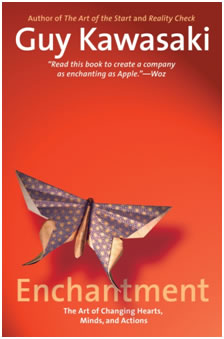 As I noted in Why Most Business Books (Still) Suck, I am generally not a fan of business books. Although many are entertaining, most fail to provide entrepreneurs with a sufficient return on their time investment. If you are a leader at a startup and you are reading a business book, you are not closing customers, raising capital, improving your product, or spending time with your loved ones.
As I noted in Why Most Business Books (Still) Suck, I am generally not a fan of business books. Although many are entertaining, most fail to provide entrepreneurs with a sufficient return on their time investment. If you are a leader at a startup and you are reading a business book, you are not closing customers, raising capital, improving your product, or spending time with your loved ones.
Unfortunately, most business books do not offer entrepreneurs an adequate payoff. However, Guy Kawasaki’s latest book, Enchantment: The Art of Changing Hearts, Minds and Actions (Enchantment) is an exception.
The short version of my review is: “Enchanting? Yes.”
If you are curious as to why a serial entrepreneur who does not generally appreciate business books gives Enchantment a thumbs-up, read on…
If you haven't already subscribed yet, subscribe now for free weekly Infochachkie articles!
Fan, Not A Fan Boy
I have used Guy’s previous book, The Art Of The Start (Art), in my UC Santa Barbara New Venture Creation class for the past five years. Quarter-after-quarter, it has inspired and enlightened my students. It has also influenced my thoughts, as evidenced by the six infoChachkie blog entries which reference Art.
I read Enchantment anticipating that it might augment my Entrepernurial Selling class, which focuses on influence and persuasion, rather than sales tactics. I was not disapointed.
Tricking The Jedi
 It is no surprise that I enjoyed Enchantment. The second most referenced author on my blog, after Kawasaki, is Robert Cialdini, co-author of Yes! 50-Scientifically Proven Ways to Be Persuasive (Yes!) and author of Influence: The Psychology Of Persuasion. Enchantment cites Mr. Cialdini throughout. Guy even gives him a nod in his index, indicating that thought leaders often assess a new book by flipping to the index to see if their name is included. At the beginning of the index, Guy writes, “I hope Robert Cialdini checks this index.” No doubt, he did.
It is no surprise that I enjoyed Enchantment. The second most referenced author on my blog, after Kawasaki, is Robert Cialdini, co-author of Yes! 50-Scientifically Proven Ways to Be Persuasive (Yes!) and author of Influence: The Psychology Of Persuasion. Enchantment cites Mr. Cialdini throughout. Guy even gives him a nod in his index, indicating that thought leaders often assess a new book by flipping to the index to see if their name is included. At the beginning of the index, Guy writes, “I hope Robert Cialdini checks this index.” No doubt, he did.
Enchantment complements these widely-read works by focusing influence and persuasion through an entrepreneurial lens. For instance, Guy refers to an entrepreneur’s venture as their “cause.” A cause can be a: non-profit, Internet startup, idea, political opinion, or coffee shop. Anything that you are passionate about and are willing to expend energy to motivate others to support, qualifies as a cause.
Guy utilizes a pragmatic, hands-on approach, which provides readers with tools to enhance their persuasion capabilities, rather than simply presenting them a non-actionable narrative. For instance, the table of contents also serves as a checklist by which the reader can keep track of the persuasion skills they have mastered.
At the conclusion of Enchantment, Guy includes a 20-question test which enables readers to assess their persuasion capabilities. He then helps readers evaluate their results with some amusing “grades.” For instance, he classifies test-takers scoring between 19 and 20 as, “You can teach Steve Jobs a thing or two,” while he suggests to those scoring between zero and five that they should, “Ask Guy for a refund.” I scored 18, which entitles me to “Go forth and enchant.”
This practical approach also manifests itself in Guy’s action-oriented section headings. For instance, in the chapter entitled, “How To Enchant Your Boss”, readers are instructed to:
- Make Your Boss Look Good
- Drop Everything And Do What Your Boss Asks
- Underpromise, Overdeliver
- Prototype Your Work
- Show And Broadcast Progress
- Form Friendships
- Ask For Mentoring
- Deliver Bad News Early
Things I Loved
- Pithy – Guy is the Steven King of business books. Like King, his writing style is breezy and engaging. The brief chapters lend themselves to multiple sittings, allowing a busy entrepreneur to read each chapter in short increments.
- Little Bull Shitake – Guy’s stature in the business publishing world allows him to talk straight. For instance, he pointedly describes the petty nature of the negative feedback he received when he asked his blog readers to submit cover art on spec. Guy is enchanting without pulling his punches.
- Quotes – Guy’s use of quotes is hardly unique. However, the quotes he uses are particularly thoughtful and effectively set the stage for the text that follows. My favorite quotes, along with the corresponding headings include:

- Phrasing – Fluency is the ease by which people comprehend the information communicated to them. The easier a concept is to understand and recall, the more influential the concept. Guy takes this approach to heart with the use of memorable phrasing, such as:
“flow with the go”
“Facebook is for show, LinkedIn is for dough”
“familiarity breeds commitment”
“artificial dissemination”
- Honesty – As in Art, Guy stresses the importance of Honesty and encourages his readers to act as mensch and freely do good deeds. He notes that enchantment borne of deception is fleeting.
- Field Manual – Enchantment is a practical how-to book that entrepreneurs can repeatedly refer to when tackling specific issues, such as; “How To Overcome Resistance”, “How To Use Push Technology” or, “How To Enchant Your Employees.”
- Accessible – Guy stresses that enchantment is open to everyone who is likeable, trustworthy and has an awesome cause. This inclusive approach motivates emerging entrepreneurs by demystifying the paths to success.
Things I Liked
- Bibliography – Students of persuasion will appreciate the inclusion of a comprehensive list of current and classic books that can augment their ability to influence others.
- Sidebars – Each chapter concludes with a personal story describing a significant enchanting event in the lives of various entrepreneurs. Most of these life-stories loosely reinforce each chapter’s topic.
- Photos – Guy, an avid photographer, includes a number of candid photos that give the book an intimate, genuine flavor seldom seen in mass market business books.
Things I Liked Less
- Cover Story – After the index, Guy includes a few pages that describe the “making of” the book’s cover. I am sure this was an exciting process for everyone concerned, but it is better suited to a blog entry, rather than the epilogue.
- Concentration – As noted above, I am a big fan of Cialdini. However, greater exposure to studies performed by other, less widely-read persuasion experts would have been appreciated.
- Obsolescence – By Guy’s own admission, his references to current technologies, such as Facebook, Twitter, and LinkedIn build in an implicit shelf-life. My hope is that he and his publisher diligently update future editions of Enchantment to include emerging technologies while removing those that are obsolete.
Positive ROI
 Guy’s greatest insight is that, “Enchantment is a process, not an event.” One might logically extend this quote to say, “Enchantment is not a process, it is a way of life.” By nature, entrepreneurs are impatient and typically seek quick solutions so they can advance to the next challenge. However, as Guy makes clear, enchantment is not a silver bullet. It will not immediately resolve your startup’s problems, but will significantly reduce the overall friction of your adVenture’s journey.
Guy’s greatest insight is that, “Enchantment is a process, not an event.” One might logically extend this quote to say, “Enchantment is not a process, it is a way of life.” By nature, entrepreneurs are impatient and typically seek quick solutions so they can advance to the next challenge. However, as Guy makes clear, enchantment is not a silver bullet. It will not immediately resolve your startup’s problems, but will significantly reduce the overall friction of your adVenture’s journey.
I highly recommend Enchantment for both experienced and emerging entrepreneurs. The time spent reading Enchantment will net a significant return. Buy a copy for yourself, your Core Team and your key employees – anyone who is in a position to enchant your Donors, investors, employees, customers, and other stakeholders. I look forward to incorporating Enchantment into my Selling classes’ curriculum.



